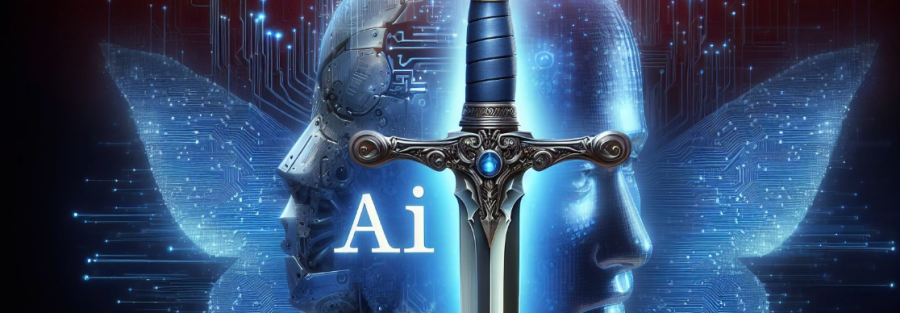The Dual-Edged Sword: AI as a Weapon for Attackers
Artificial Intelligence (AI) has revolutionized the world in countless ways, enhancing efficiency, automation, and innovation across industries. However, like any transformative technology, AI is a double-edged sword. While its benefits are undeniable, the rise of AI-powered tools in the hands of malicious actors presents a growing and alarming threat landscape. This blog delves into how AI is being weaponized by attackers and why this poses a critical challenge for cybersecurity and global security.

How Attackers are Leveraging AI
- Automated Phishing Attacks Traditional phishing attacks rely on generic emails or messages that often fail to deceive vigilant users. With AI, attackers can craft highly personalized and convincing phishing campaigns at scale. Machine learning algorithms can analyze publicly available data from social media and other sources to create emails that appear tailored to specific individuals, significantly increasing the success rate of these attacks.
- Deepfake Technology Deepfakes leverage AI to create hyper-realistic images, audio, and videos that can deceive even trained professionals. Attackers have used deepfakes for purposes such as impersonating executives during virtual meetings to authorize fraudulent transactions or launching disinformation campaigns to sow chaos and distrust.
- AI-Powered Malware AI can enhance malware by enabling it to adapt to and evade detection mechanisms. For instance, AI-powered malware can analyze the defenses of a target system in real time, modify its behavior to avoid detection, and exploit vulnerabilities more effectively. This dynamic adaptability makes AI-driven malware significantly more dangerous than traditional static threats.
- Credential Stuffing and Password Cracking AI algorithms excel at pattern recognition and brute-force tasks, making them ideal for cracking passwords. Attackers can train AI systems to identify patterns in commonly used passwords or automate credential stuffing attacks across multiple platforms with unprecedented speed and accuracy.
- Exploitation of IoT Devices The proliferation of Internet of Things (IoT) devices presents a fertile ground for attackers. AI can be used to scan for vulnerabilities in IoT ecosystems, identify weak points, and coordinate massive botnets for Distributed Denial-of-Service (DDoS) attacks.
- Social Engineering at Scale Natural Language Processing (NLP) advancements allow attackers to create convincing chatbots or automated responses that mimic human interaction. These AI-powered tools can manipulate individuals into divulging sensitive information or performing harmful actions without realizing they are interacting with a malicious actor.
The Challenges of Countering AI-Powered Threats
- Speed and Scale AI enables attackers to automate their operations, launching attacks with speed and scale that far exceed human capabilities. Defensive teams often struggle to keep pace with the sheer volume and sophistication of these threats.
- Detection Complexity AI-powered attacks can blend in seamlessly with legitimate activities, making detection extremely challenging. For example, AI-generated phishing emails or deepfake content often bypass traditional filters and human scrutiny.
- Asymmetric Advantage While defenders must protect every potential entry point, attackers need only find a single vulnerability. AI tilts this asymmetry further by enabling attackers to probe defenses more efficiently and relentlessly.
- Resource Disparity Many organizations lack the resources to implement advanced AI-driven defense systems. This creates an uneven playing field where well-funded attackers can exploit less-equipped targets with ease.
Mitigation Strategies
- AI for Defense Organizations can harness AI to bolster their defenses. Machine learning algorithms can identify anomalies, detect threats in real time, and predict potential vulnerabilities before they are exploited. By fighting fire with fire, defenders can stay ahead of attackers.
- Continuous Education and Awareness Human vigilance remains critical. Regular training programs can help employees recognize AI-generated phishing attempts and other forms of social engineering. Awareness campaigns should evolve alongside emerging threats.
- Collaborative Efforts Governments, private companies, and researchers must work together to establish standards, share threat intelligence, and develop countermeasures against AI-driven attacks. Collective action is essential to outpace adversaries.
- Robust Regulations Policymakers must address the ethical and security implications of AI. Stricter regulations around the use and development of AI technologies can reduce the likelihood of misuse.
- Investing in Cyber Hygiene Basic cybersecurity practices, such as multi-factor authentication, regular software updates, and network segmentation, remain effective against many threats. Strengthening these foundational defenses can minimize exposure to AI-powered attacks.
The Road Ahead
As AI continues to evolve, so too will its applications—both benevolent and malicious. The weaponization of AI by attackers is not a distant possibility; it is a present reality. Recognizing and addressing this threat proactively is paramount to ensuring that the benefits of AI are not overshadowed by its potential harms. By adopting a multifaceted approach that combines technology, education, and collaboration, we can tip the scales in favor of security and resilience.
AI may be a dual-edged sword, but with the right strategies, we can ensure it becomes a shield as much as it is a weapon.




